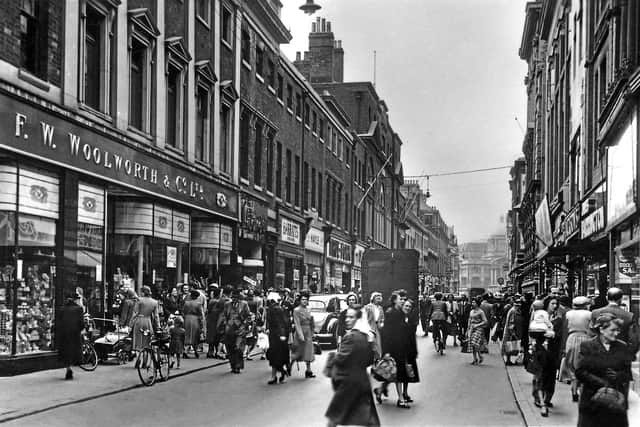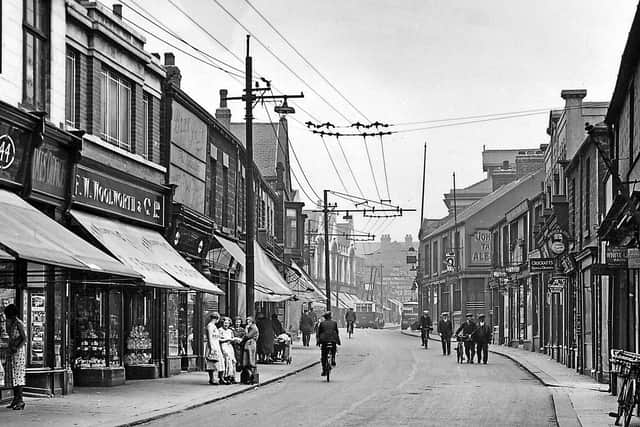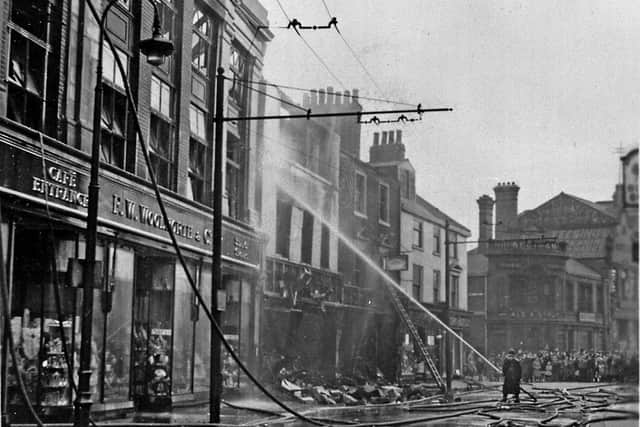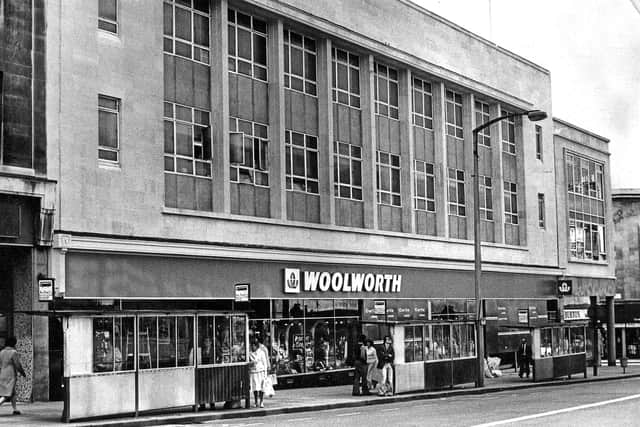Woolworths: A history of the famous high street stores in Yorkshire
He intended to establish in England a chain of shops each containing more than 100,000 varieties of household items. He would sell them for either 1d, 2d, or 6d.
It was reported the articles on sale would range from live goldfish in green glass bowls to potted plants, clothes-baskets, and workmen’s overalls. British labour was to benefit. Woolworth stated that he planned not only to have a large proportion of his goods manufactured in England but, so far as was practicable, to employ British workers only.
Advertisement
Hide AdAdvertisement
Hide AdBorn in Rodman, New York on April 13, 1852, Woolworth, as a boy was ridiculed in an upmarket US store because he only had a small amount of change to buy his mother a birthday present. He told his brother one day he would have his own store where people would be able to buy five or even ten items for fifty cents.


F.W. Woolworth’s first UK store was opened in Liverpool’s Church Street on Friday November 5, 1909. He had chosen the site after a nationwide tour. No goods were sold on that day, the building was open for inspection only, with music played from 2pm to 9pm. The premises opened for business the following day and were thronged with customers.
The British venture was led by Woolworth’s cousin, Fred, along with three volunteers from New York State. One paper said the first store offered tomahawks and was thus a cowboy operation.
Further Woolworth shops were opened in Preston (February 1910); Liverpool London Road, February 1910; and Manchester, 1910.
Advertisement
Hide AdAdvertisement
Hide AdYorkshire’s first Woolworth store – the company’s fifth outlet – was located in The Exchange Buildings at 131 Briggate, Leeds. The opening followed the same pattern as the first store in Liverpool. The branch was open for inspection on Friday March 18, 1910.


The Yorkshire Evening Post reported: ‘No goods sold this day. But the public are invited to freely inspect the beautiful building and big vales. The doors were open for business the following day with the announcement: ‘Nothing in the stores over 6d’.
Next to open was a store in Hull’s Whitefriargate on November 4, 1910. Many years later, an article from March 1967 said the opening was an anticlimax. Warned that there had been chaos at other openings, the management took precautions. Barriers were in place and all was ready before the opening.
The article added: ‘At nine o’clock the doors were unlocked – and a solitary man charged through the door, ran the length of the counters, bought a tin of brass polish and ran out again. The second customer did not arrive until eleven o’clock.’
Advertisement
Hide AdAdvertisement
Hide AdNext to welcome Woolworths in Yorkshire was Bradford, during September 1914, the store located in Darley Street. Prior to the opening one journalist had looked round the premises and wrote that articles could be purchased ‘of almost illimitable variety and indispensable to every home.’ He continued: ‘Even a three-course lunch can be had for sixpence and it will consist of wholesome food and served with promptitude. ’A year later Huddersfield welcomed a Woolworths store.


Frank Woolworth was planning elaborate 40th birthday celebrations for his stores just before he died aged 66 on April 8 1919. His obituary in the New York Times commented: ‘He made his money not by selling a little for a lot, but by selling a lot for a little’. Just over a week later, an account stated that the estate of Frank W. Woolworth amounted to £8,000,000.
Woolworths stores proliferated in Yorkshire during the 1920s. They included Huddersfield, 1920; Wakefield 1920; Dewsbury, 1921; Harrogate, 1923; Halifax 1923; and Sheffield The Moor, 1923.
Large Woolworth’s stores, some on several levels, and with thousands of items for sale found favour with shoplifters. Local newspapers throughout the country recorded many incidents of shoplifting at the company’s stores. The method of conducting business and dealing with shoplifting at the new Woolworth’s shop on The Moor brought strong comments by magistrates at Sheffield Police Court on October 15, 1923.
Advertisement
Hide AdAdvertisement
Hide AdTwo girls were charged with thefts from the shop and one pleaded not guilty. Woolworth’s local manager said that the firm had sustained tremendous loss by petty thefts during the past week, and they could have brought 50 or 60 cases of a similar character.


When questioned by Alderman Wardley, he stated that no receipts were given to customers. The Alderman commented: ‘Could you not bring the same sort of charge against anybody who made purchases at your shop? At other shops one gets tickets or receipts, which would prove purchases.’
Later, Wardley remarked that he was pleased with the desire expressed by the manager that the two cases should be withdrawn.
Woolworth’s moved its Leeds site to Briggate on December 1, 1923. The Yorkshire Evening Post reported that for eight months people in the city had watched the old buildings, which included the Albion Hotel, being demolished. Then, they had seen ‘the spick and span, new premises, with their shining terracotta front, rising in their place’.
Advertisement
Hide AdAdvertisement
Hide AdHubert T. Parsons, president of the F.W. Woolworth company said during late 1924: ‘We now have 165 stores operating in the British Isles, and before the end of 1925 we expect to have 200. In the United States we are operating 1,365 stores.’
Woolworth’s arrived in Mexborough near Rotherham with the opening of an outlet on August 4, 1928. One paper said the edifice represented something of a minor miracle in its construction. It was completed in under 17 weeks ‘a feat accomplished by American hustle under Scottish direction and performed by local labour.’
B.C. Donaldson, the firm’s chief architect was responsible for the plans. There were 40 girls employed at Mexborough branch, all of them from Mexborough or neighbouring villages. With one or two exceptions the girls took their meals – dinner and tea – in the dining room behind the shop. Work began at 8.30 every morning, and an hour was allowed for dinner and half an hour for tea, the meals being served in three shifts.
Besides reports of shoplifting in the press, there were a few instances of fires mentioned in the Woolworth’s stores. On May 6, 1938, there was an outbreak of fire at Doncaster, the worst in living memory in the town. It originated in Verity’s Baxter Gate drapery establishment and spread to the adjacent Woolworth’s building despite a thick wall intervening. At one point, a warning was broadcast by loudspeakers that the front of Woolworth’s store was likely to collapse at any moment. Staff had removed their takings and books before the fire engulfed the building.
Advertisement
Hide AdAdvertisement
Hide AdAt the company’s annual meeting in January 1938, the chairman said that the total number of branches had been brought up to 711. During January 1940, it was announced Woolworth’s UK stores yielded a profit of £7,612,000 the biggest ever achieved.
Success continued in the post war years. Figures revealed in January 1949 showed a net profit after taxation amounting to £4,487,247. In 1964 came the headline ‘Woolworth’s Profits Ring up a £37m record’.
Stores continued to be built and rebuilt. In Sheffield after heavy German bombing during WWII on the Moor, new premises were built afterwards. A new store was opened at 34 – 36 Haymarket Sheffield in 1959. In Leeds, the Seacroft Civic Centre was opened by Queen Elizabeth II in 1965. The area boasted a Grandways supermarket and a Woolworths as well as many other facilities.
Woolworth’s faded in the USA and Canada during the 1990s. In Britain, the company collapsed with closure of hundreds of stores between December 27, 2008 and January 6, 2009, resulting 27,000 job losses.
With thanks to Susan Stepan and Helen Skilbeck at Leeds Libraries for help with this piece.
Comment Guidelines
National World encourages reader discussion on our stories. User feedback, insights and back-and-forth exchanges add a rich layer of context to reporting. Please review our Community Guidelines before commenting.